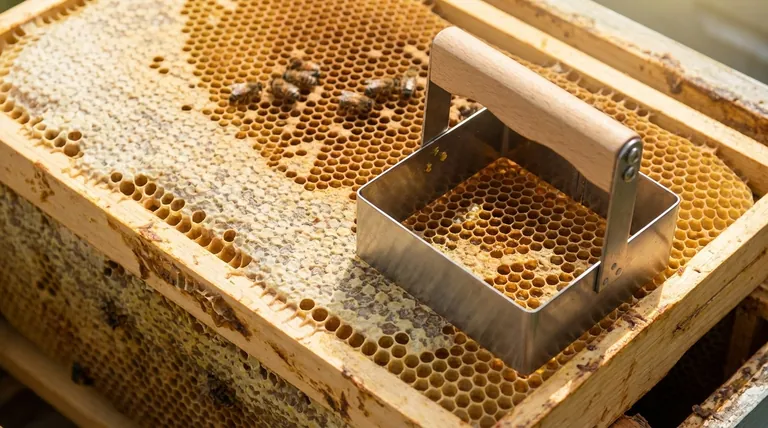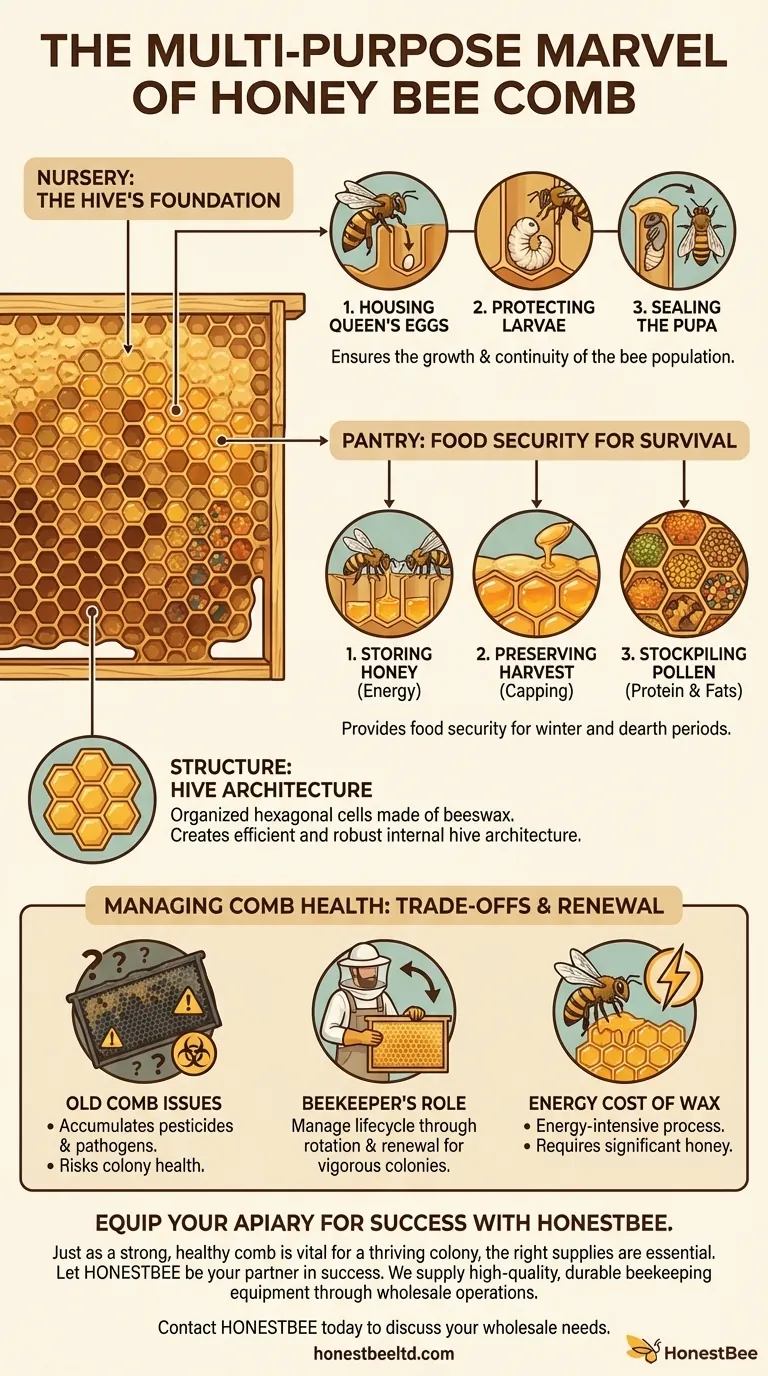In short, honey bee comb is a multi-purpose marvel built from beeswax that serves as the colony's nursery, pantry, and internal structure. Bees use its hexagonal cells to raise their young (brood), store long-term food supplies like honey and pollen, and organize the entire function of the hive.
The honeycomb is not merely a storage container; it is the very heart of the colony. It functions as a combined nursery for raising new generations and a meticulously organized pantry for surviving harsh seasons.

The Comb as the Hive's Nursery
The primary purpose of the comb, especially in the central part of the hive known as the brood nest, is to house the next generation of bees.
Housing the Queen's Eggs
The queen bee methodically lays a single egg in the bottom of each pristine wax cell. The comb's structure provides a protected and organized space for tens of thousands of future bees.
Protecting Developing Bees
Once the egg hatches, the cell becomes a nursery chamber for the larva. Worker bees feed the larva within this cell until it is large enough to pupate.
Sealing the Pupa
After the larval stage, worker bees cap the cell with wax. Inside this sealed, protected chamber, the pupa transforms into an adult bee, eventually chewing its way out to join the colony.
The Comb as the Colony's Pantry
Beyond reproduction, the comb is the colony’s solution for food security. Bees use cells to store the resources they need to survive winter and periods of low nectar flow.
Storing Honey
Worker bees fill comb cells with nectar, which they then dehydrate into honey. This is their essential carbohydrate source, packed with the energy needed to survive the cold.
Preserving the Harvest with Capping
Once the honey in a cell reaches the correct low moisture content, bees seal it with a fresh wax lid. This capping is critical, as it prevents the honey from absorbing humidity and spoiling.
Stockpiling Pollen
Bees also pack cells with pollen, their primary source of protein and fats. This "bee bread" is vital for feeding developing larvae and ensuring the colony's overall health.
Understanding the Trade-offs
While essential, the comb is not a permanent, flawless structure. Its management involves a balance between the bees' natural work and the need for a healthy hive environment.
The Problem with Old Comb
Over time, comb can become dark and contaminated. It may accumulate pesticide residues from the environment or harbor pathogens, making comb renewal a critical practice for maintaining bee health.
The Energy Cost of Wax
Producing beeswax is an energy-intensive process for honey bees. To create new comb, they must consume significant amounts of honey, which is why beekeepers often provide "drawn comb" to give their colonies a head start.
The Beekeeper's Role
Beekeepers often manage the lifecycle of comb, removing old frames and encouraging the bees to build fresh, clean wax. This practice helps prevent disease and ensures the colony remains vigorous.
How This Applies to Hive Success
Understanding the comb's multiple functions reveals why it is the central pillar of a colony's survival and productivity.
- If your primary focus is understanding bee biology: View the comb as the physical manifestation of the colony's strategy for reproduction and long-term survival.
- If your primary focus is practical beekeeping: Recognize that managing comb health through rotation and renewal is one of your most important jobs for ensuring a productive and disease-free colony.
Ultimately, the honeycomb is the architectural and biological masterpiece that makes the complex social life of the honey bee possible.
Summary Table:
| Primary Function | Key Activity | Benefit to the Colony |
|---|---|---|
| Nursery | Queen lays eggs; larvae develop; pupae sealed | Ensures the growth and continuity of the bee population. |
| Pantry | Stores honey and pollen; cells are capped for preservation | Provides food security to survive winter and dearth periods. |
| Structure | Organized hexagonal cells made of beeswax | Creates an efficient and robust internal hive architecture. |
Equip your apiary for success with HONESTBEE. Just as a strong, healthy comb is vital for a thriving colony, having the right beekeeping supplies is essential for your commercial or distribution operation. Let HONESTBEE be your partner in success. We supply high-quality, durable beekeeping equipment and supplies through our wholesale-focused operations, helping you manage hive health and maximize productivity.
Contact HONESTBEE today to discuss your wholesale needs and discover how our supplies can support the foundation of your beekeeping success.
Visual Guide

Related Products
- Heavy Duty Stainless Steel Honeycomb Cutter
- Plastic Handle Single Row Artificial Fiber Bee Brush
- Electric Honey Press Machine for Squeezing Honey Comb Press Equipment
- Commercial Grade Vertical Electric Bee Sweeper for Bee Removal
- Hexagonal Glass Honey Jars with Metal Lug Caps Elegant Versatile Packaging
People Also Ask
- What qualities are important for someone starting in beekeeping? Build a Thriving Apiary with the Right Mindset
- What is required to be a beekeeper? Essential Equipment, Knowledge & Mindset
- What are the features of a stainless steel honey uncapping knife? Unlock a Cleaner, More Efficient Harvest
- What type of honey extractor is best? Maximize Your Harvest Efficiency with the Right Choice
- How should combs with honey be handled during harvesting? A Beekeeper's Guide to a Clean, Efficient Harvest



















